Project Management: Sheng Siong Personal Care Product Launch Project
VerifiedAdded on 2020/03/16
|14
|2866
|127
Project
AI Summary
This project management assignment focuses on the launch of personal care products in Sheng Siong, a supermarket in Singapore. It begins with an introduction outlining the project's objectives and the importance of expanding into personal care. The assignment then delves into the use of network diagrams and Gantt charts for project planning and execution. It explores risk management, resource scheduling, and strategies for reducing project duration, including outsourcing. The paper also covers monitoring project progress through earned value management and scheduling, and concludes with a discussion on project closure activities, including stakeholder sign-off, documentation, and performance evaluation. The project provides a comprehensive analysis of the key aspects of launching personal care products, offering insights into various project management tools and techniques to ensure successful project outcomes.
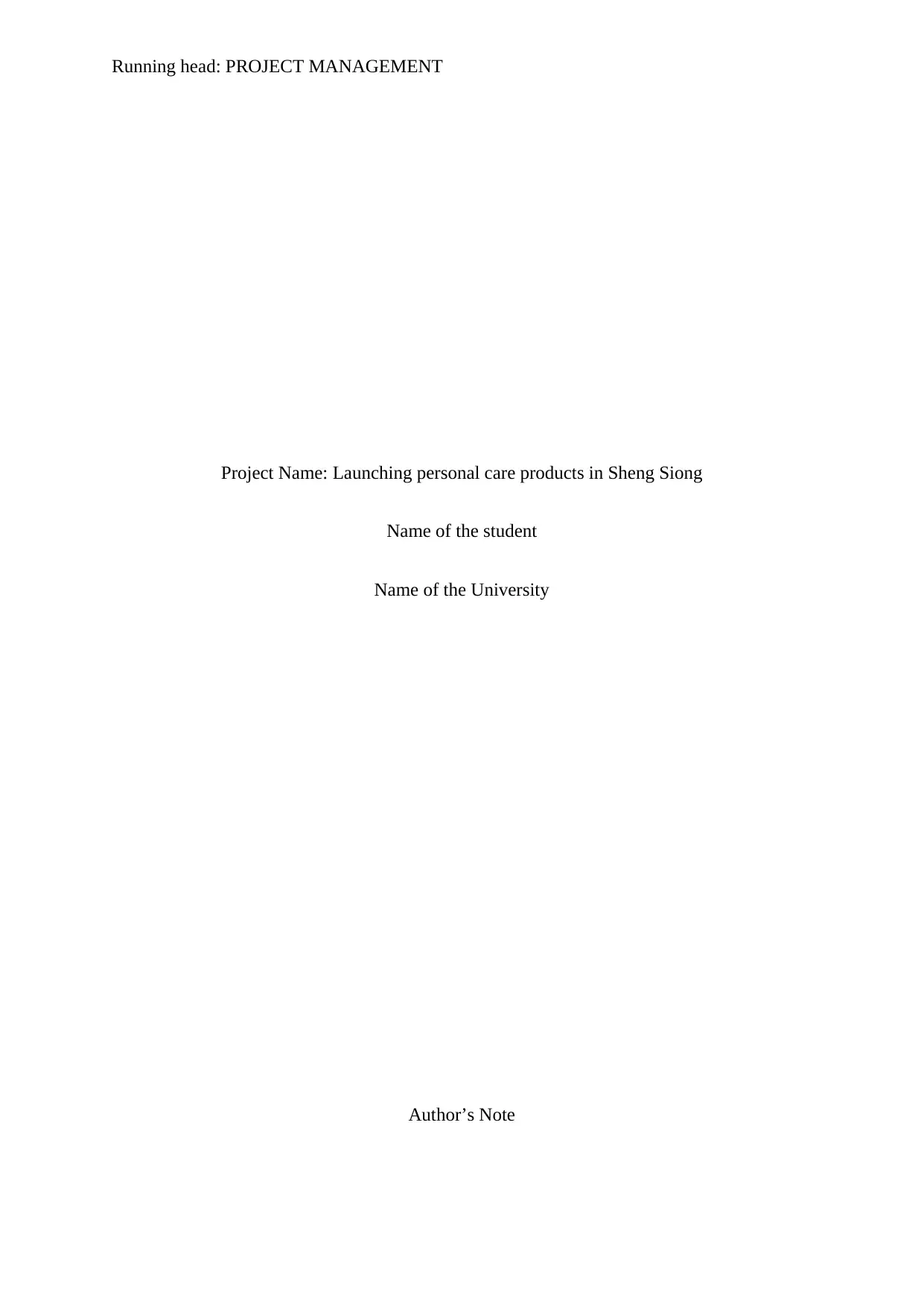
Running head: PROJECT MANAGEMENT
Project Name: Launching personal care products in Sheng Siong
Name of the student
Name of the University
Author’s Note
Project Name: Launching personal care products in Sheng Siong
Name of the student
Name of the University
Author’s Note
Paraphrase This Document
Need a fresh take? Get an instant paraphrase of this document with our AI Paraphraser

1
PROJECT MANAGEMENT
Table of Contents
1. Introduction............................................................................................................................2
2. Network and Gantt chart........................................................................................................2
2.1 Network diagram..............................................................................................................2
2.2 Gantt chart........................................................................................................................4
3. Risk management...................................................................................................................4
4. Scheduling resources..............................................................................................................7
5. Reducing project duration......................................................................................................8
6. Outsourcing............................................................................................................................9
7. Monitoring progress.............................................................................................................10
8. Project closure......................................................................................................................11
8.1 Explanation....................................................................................................................11
8.2 Wrapping closure activities............................................................................................11
8.3 Performance evaluation..................................................................................................11
8.4 Retrospectives................................................................................................................12
References................................................................................................................................13
PROJECT MANAGEMENT
Table of Contents
1. Introduction............................................................................................................................2
2. Network and Gantt chart........................................................................................................2
2.1 Network diagram..............................................................................................................2
2.2 Gantt chart........................................................................................................................4
3. Risk management...................................................................................................................4
4. Scheduling resources..............................................................................................................7
5. Reducing project duration......................................................................................................8
6. Outsourcing............................................................................................................................9
7. Monitoring progress.............................................................................................................10
8. Project closure......................................................................................................................11
8.1 Explanation....................................................................................................................11
8.2 Wrapping closure activities............................................................................................11
8.3 Performance evaluation..................................................................................................11
8.4 Retrospectives................................................................................................................12
References................................................................................................................................13
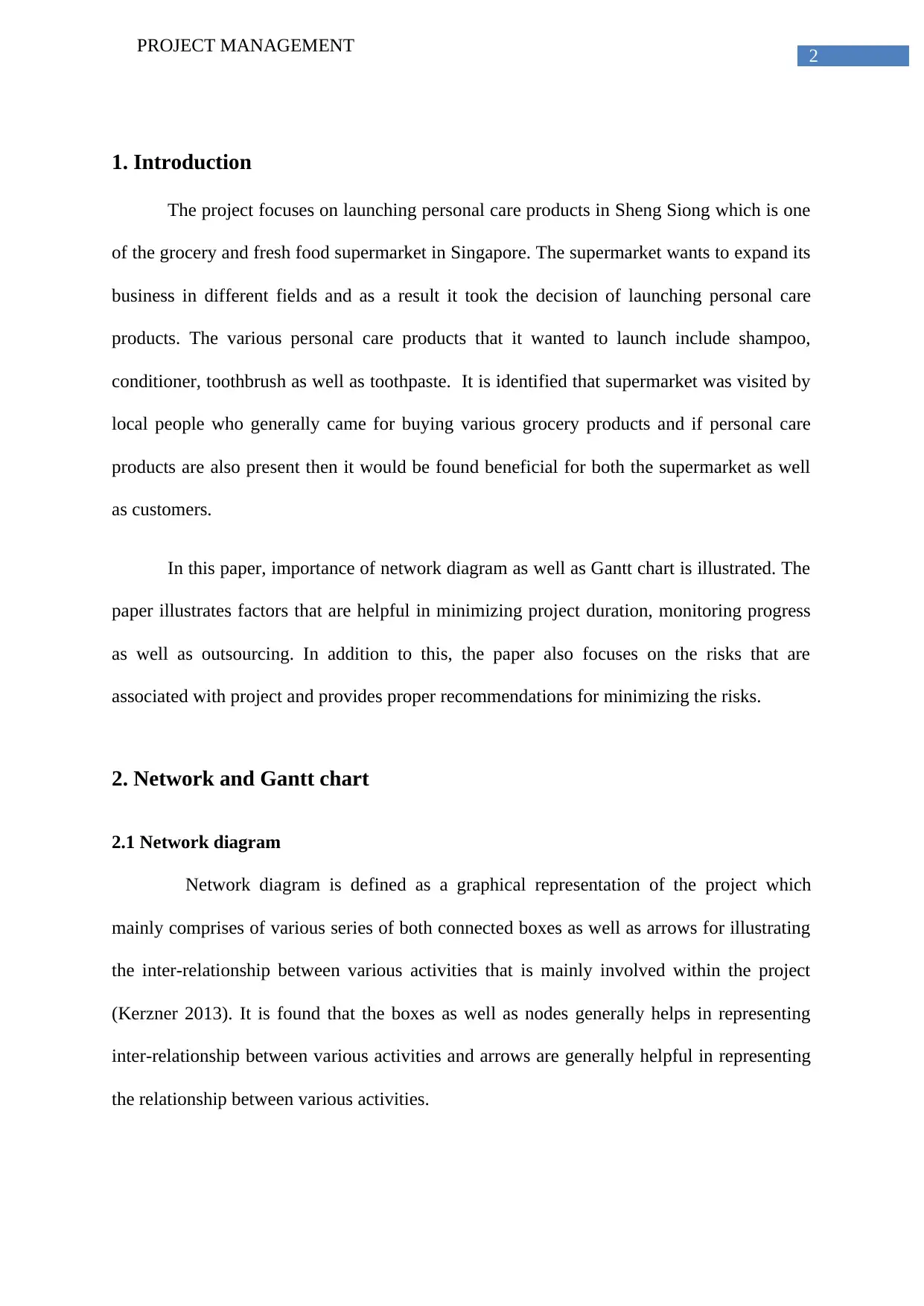
2
PROJECT MANAGEMENT
1. Introduction
The project focuses on launching personal care products in Sheng Siong which is one
of the grocery and fresh food supermarket in Singapore. The supermarket wants to expand its
business in different fields and as a result it took the decision of launching personal care
products. The various personal care products that it wanted to launch include shampoo,
conditioner, toothbrush as well as toothpaste. It is identified that supermarket was visited by
local people who generally came for buying various grocery products and if personal care
products are also present then it would be found beneficial for both the supermarket as well
as customers.
In this paper, importance of network diagram as well as Gantt chart is illustrated. The
paper illustrates factors that are helpful in minimizing project duration, monitoring progress
as well as outsourcing. In addition to this, the paper also focuses on the risks that are
associated with project and provides proper recommendations for minimizing the risks.
2. Network and Gantt chart
2.1 Network diagram
Network diagram is defined as a graphical representation of the project which
mainly comprises of various series of both connected boxes as well as arrows for illustrating
the inter-relationship between various activities that is mainly involved within the project
(Kerzner 2013). It is found that the boxes as well as nodes generally helps in representing
inter-relationship between various activities and arrows are generally helpful in representing
the relationship between various activities.
PROJECT MANAGEMENT
1. Introduction
The project focuses on launching personal care products in Sheng Siong which is one
of the grocery and fresh food supermarket in Singapore. The supermarket wants to expand its
business in different fields and as a result it took the decision of launching personal care
products. The various personal care products that it wanted to launch include shampoo,
conditioner, toothbrush as well as toothpaste. It is identified that supermarket was visited by
local people who generally came for buying various grocery products and if personal care
products are also present then it would be found beneficial for both the supermarket as well
as customers.
In this paper, importance of network diagram as well as Gantt chart is illustrated. The
paper illustrates factors that are helpful in minimizing project duration, monitoring progress
as well as outsourcing. In addition to this, the paper also focuses on the risks that are
associated with project and provides proper recommendations for minimizing the risks.
2. Network and Gantt chart
2.1 Network diagram
Network diagram is defined as a graphical representation of the project which
mainly comprises of various series of both connected boxes as well as arrows for illustrating
the inter-relationship between various activities that is mainly involved within the project
(Kerzner 2013). It is found that the boxes as well as nodes generally helps in representing
inter-relationship between various activities and arrows are generally helpful in representing
the relationship between various activities.
⊘ This is a preview!⊘
Do you want full access?
Subscribe today to unlock all pages.

Trusted by 1+ million students worldwide
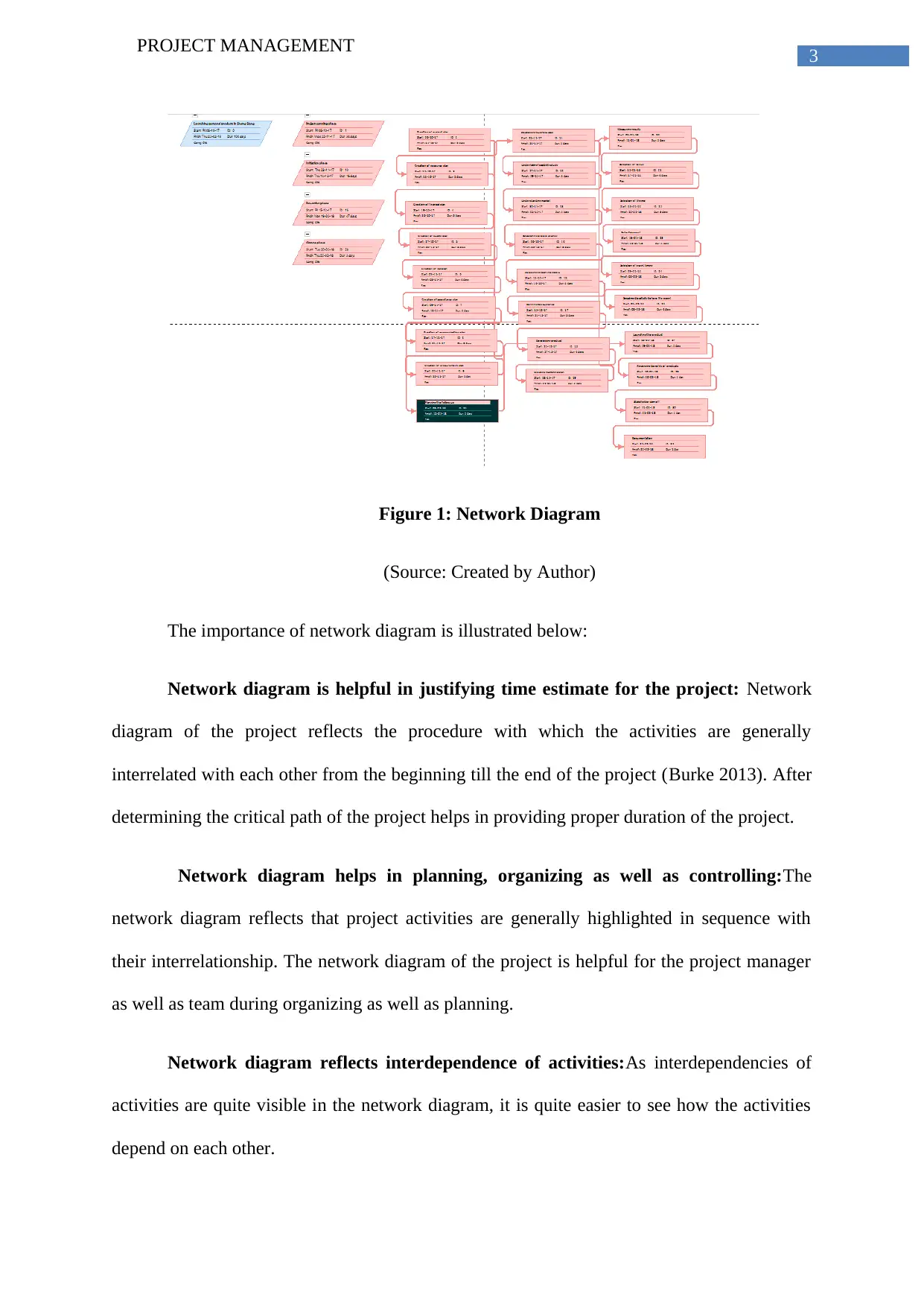
3
PROJECT MANAGEMENT
Figure 1: Network Diagram
(Source: Created by Author)
The importance of network diagram is illustrated below:
Network diagram is helpful in justifying time estimate for the project: Network
diagram of the project reflects the procedure with which the activities are generally
interrelated with each other from the beginning till the end of the project (Burke 2013). After
determining the critical path of the project helps in providing proper duration of the project.
Network diagram helps in planning, organizing as well as controlling:The
network diagram reflects that project activities are generally highlighted in sequence with
their interrelationship. The network diagram of the project is helpful for the project manager
as well as team during organizing as well as planning.
Network diagram reflects interdependence of activities:As interdependencies of
activities are quite visible in the network diagram, it is quite easier to see how the activities
depend on each other.
PROJECT MANAGEMENT
Figure 1: Network Diagram
(Source: Created by Author)
The importance of network diagram is illustrated below:
Network diagram is helpful in justifying time estimate for the project: Network
diagram of the project reflects the procedure with which the activities are generally
interrelated with each other from the beginning till the end of the project (Burke 2013). After
determining the critical path of the project helps in providing proper duration of the project.
Network diagram helps in planning, organizing as well as controlling:The
network diagram reflects that project activities are generally highlighted in sequence with
their interrelationship. The network diagram of the project is helpful for the project manager
as well as team during organizing as well as planning.
Network diagram reflects interdependence of activities:As interdependencies of
activities are quite visible in the network diagram, it is quite easier to see how the activities
depend on each other.
Paraphrase This Document
Need a fresh take? Get an instant paraphrase of this document with our AI Paraphraser
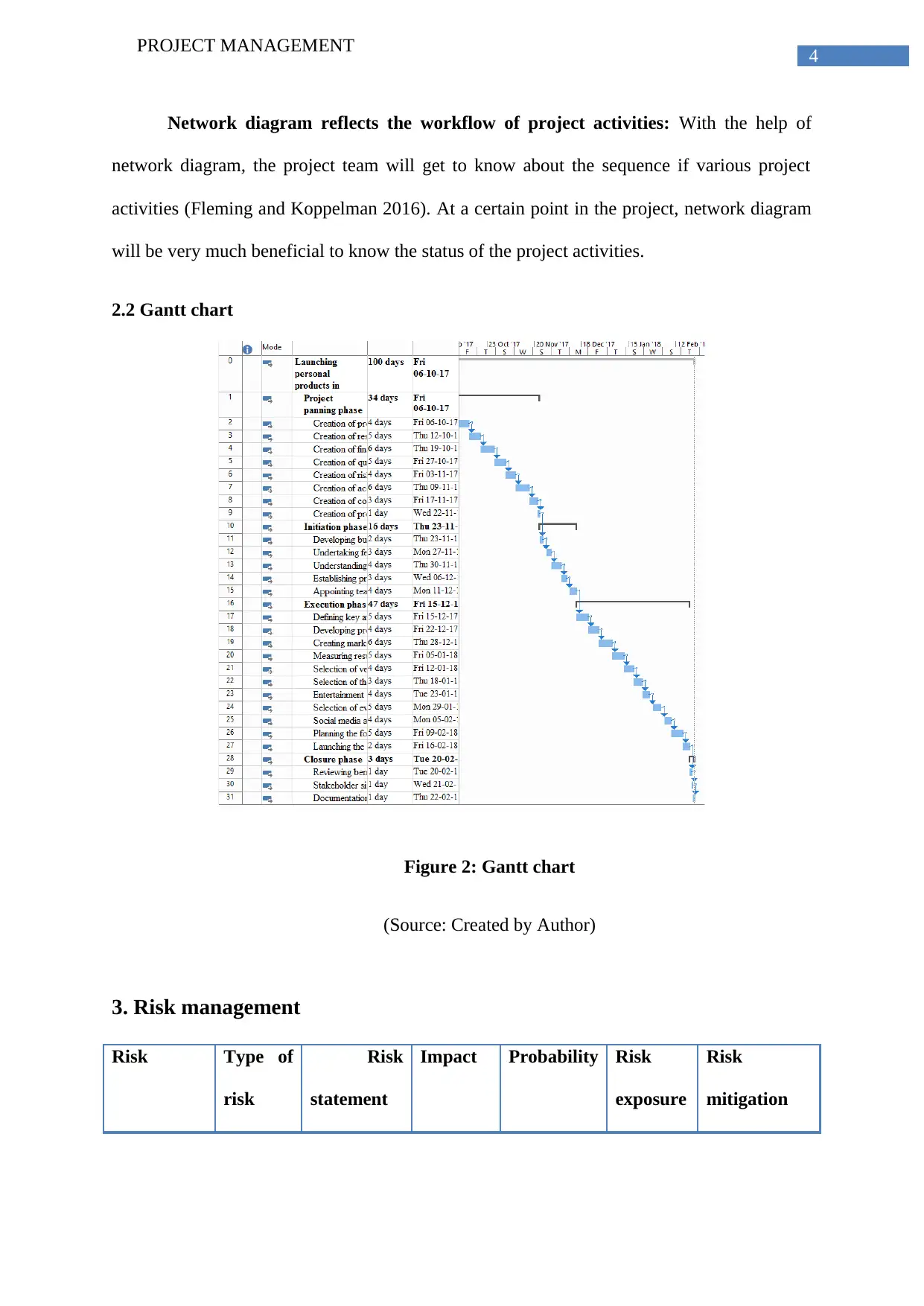
4
PROJECT MANAGEMENT
Network diagram reflects the workflow of project activities: With the help of
network diagram, the project team will get to know about the sequence if various project
activities (Fleming and Koppelman 2016). At a certain point in the project, network diagram
will be very much beneficial to know the status of the project activities.
2.2 Gantt chart
Figure 2: Gantt chart
(Source: Created by Author)
3. Risk management
Risk Type of
risk
Risk
statement
Impact Probability Risk
exposure
Risk
mitigation
PROJECT MANAGEMENT
Network diagram reflects the workflow of project activities: With the help of
network diagram, the project team will get to know about the sequence if various project
activities (Fleming and Koppelman 2016). At a certain point in the project, network diagram
will be very much beneficial to know the status of the project activities.
2.2 Gantt chart
Figure 2: Gantt chart
(Source: Created by Author)
3. Risk management
Risk Type of
risk
Risk
statement
Impact Probability Risk
exposure
Risk
mitigation
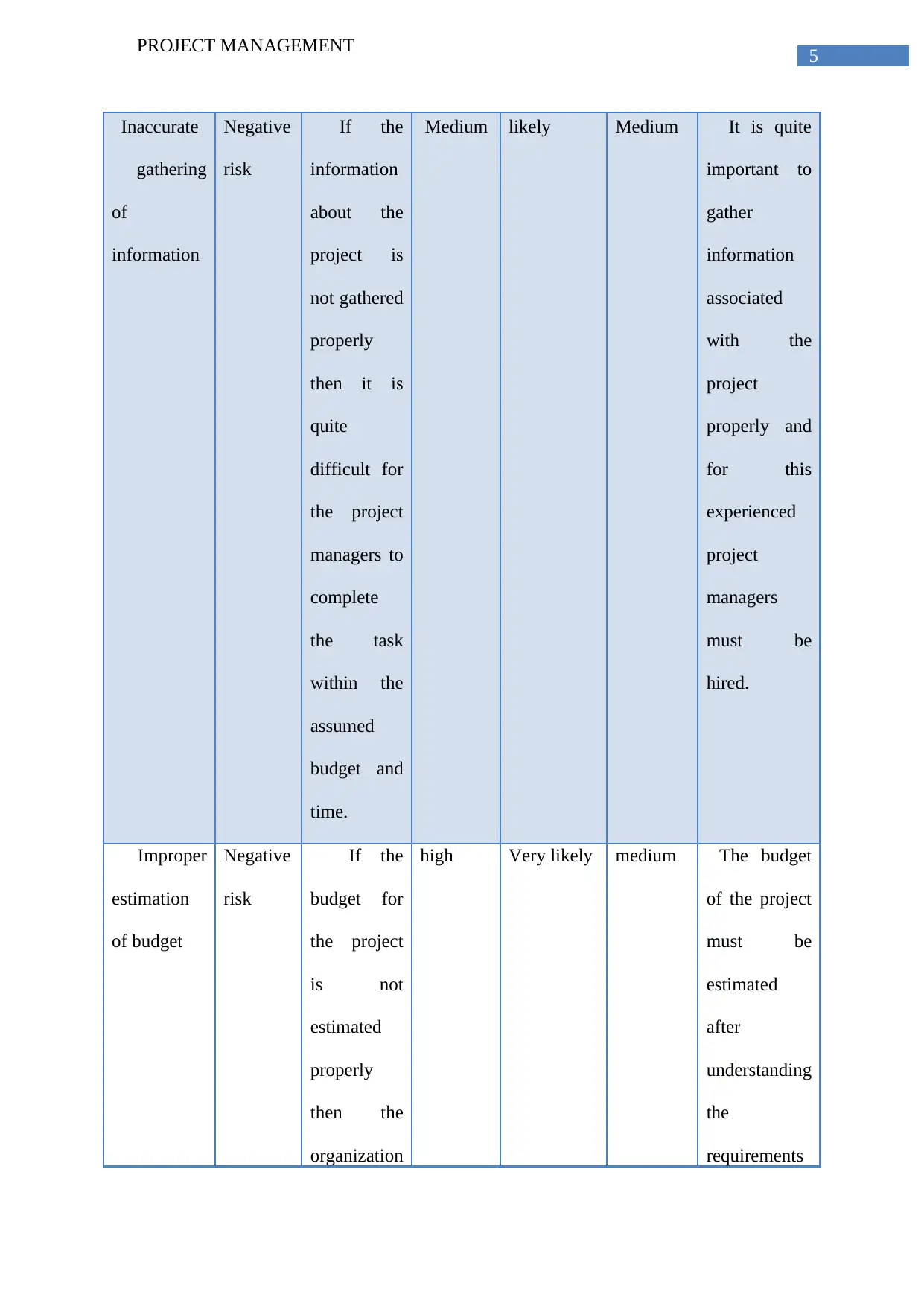
5
PROJECT MANAGEMENT
Inaccurate
gathering
of
information
Negative
risk
If the
information
about the
project is
not gathered
properly
then it is
quite
difficult for
the project
managers to
complete
the task
within the
assumed
budget and
time.
Medium likely Medium It is quite
important to
gather
information
associated
with the
project
properly and
for this
experienced
project
managers
must be
hired.
Improper
estimation
of budget
Negative
risk
If the
budget for
the project
is not
estimated
properly
then the
organization
high Very likely medium The budget
of the project
must be
estimated
after
understanding
the
requirements
PROJECT MANAGEMENT
Inaccurate
gathering
of
information
Negative
risk
If the
information
about the
project is
not gathered
properly
then it is
quite
difficult for
the project
managers to
complete
the task
within the
assumed
budget and
time.
Medium likely Medium It is quite
important to
gather
information
associated
with the
project
properly and
for this
experienced
project
managers
must be
hired.
Improper
estimation
of budget
Negative
risk
If the
budget for
the project
is not
estimated
properly
then the
organization
high Very likely medium The budget
of the project
must be
estimated
after
understanding
the
requirements
⊘ This is a preview!⊘
Do you want full access?
Subscribe today to unlock all pages.

Trusted by 1+ million students worldwide

6
PROJECT MANAGEMENT
will face
financial
pressure.
of the project
properly.
Improper
theme
selection
Negative
risk
If the
theme for
the project
is not
selected
properly
then the
organization
would face
difficulty in
launching
the
products.
High Very likely High Theme
selection of
the project
must be done
properly so
that the
products
within the
organization
can be easily
launched.
Improper
management
of social
media
activity
Negative
risk
If the
social
media
activity is
not
managed
properly
before
launching
Moderate likely medium It is quite
important to
manage the
activity of
social media
before
launching the
product in the
event
PROJECT MANAGEMENT
will face
financial
pressure.
of the project
properly.
Improper
theme
selection
Negative
risk
If the
theme for
the project
is not
selected
properly
then the
organization
would face
difficulty in
launching
the
products.
High Very likely High Theme
selection of
the project
must be done
properly so
that the
products
within the
organization
can be easily
launched.
Improper
management
of social
media
activity
Negative
risk
If the
social
media
activity is
not
managed
properly
before
launching
Moderate likely medium It is quite
important to
manage the
activity of
social media
before
launching the
product in the
event
Paraphrase This Document
Need a fresh take? Get an instant paraphrase of this document with our AI Paraphraser
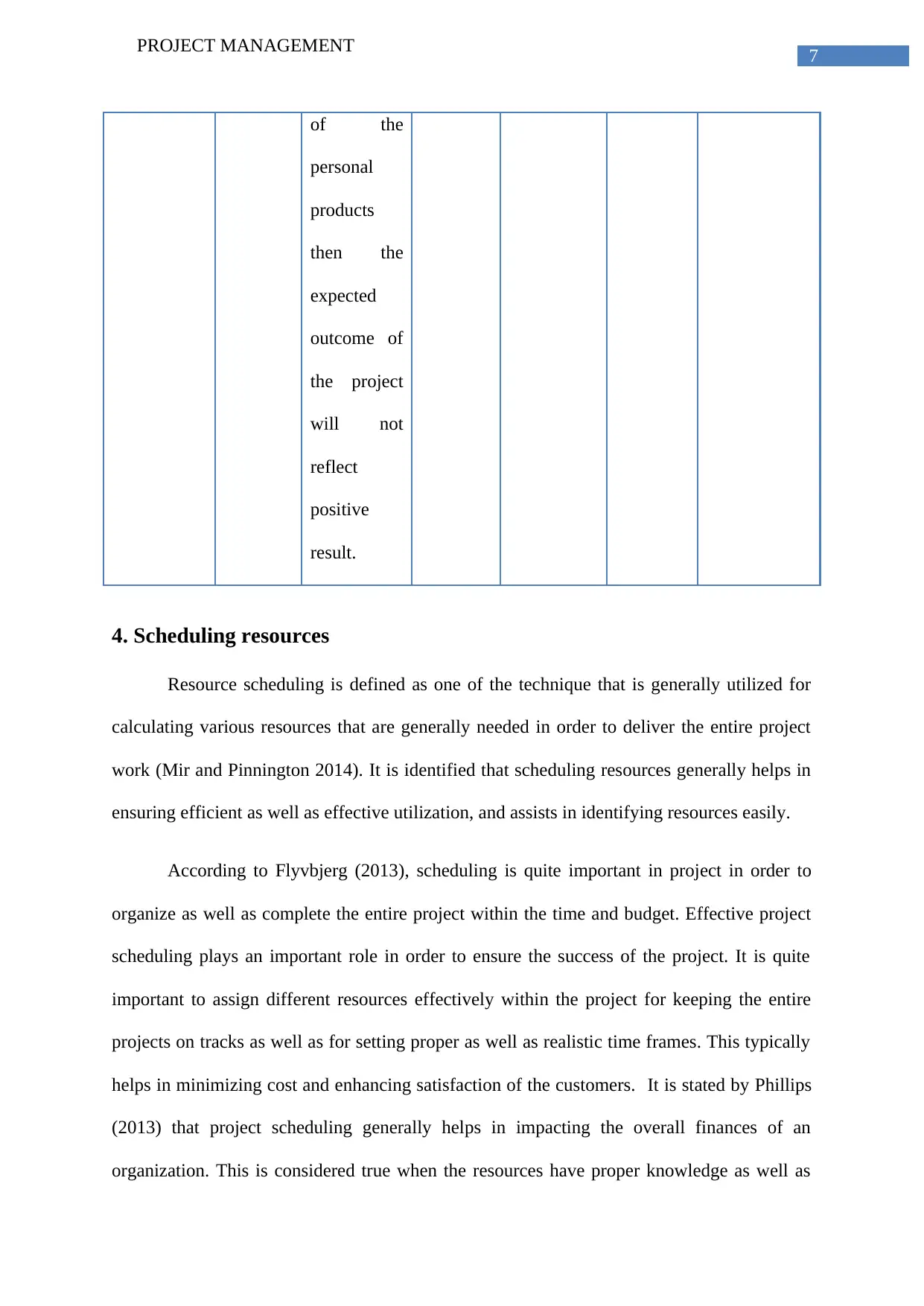
7
PROJECT MANAGEMENT
of the
personal
products
then the
expected
outcome of
the project
will not
reflect
positive
result.
4. Scheduling resources
Resource scheduling is defined as one of the technique that is generally utilized for
calculating various resources that are generally needed in order to deliver the entire project
work (Mir and Pinnington 2014). It is identified that scheduling resources generally helps in
ensuring efficient as well as effective utilization, and assists in identifying resources easily.
According to Flyvbjerg (2013), scheduling is quite important in project in order to
organize as well as complete the entire project within the time and budget. Effective project
scheduling plays an important role in order to ensure the success of the project. It is quite
important to assign different resources effectively within the project for keeping the entire
projects on tracks as well as for setting proper as well as realistic time frames. This typically
helps in minimizing cost and enhancing satisfaction of the customers. It is stated by Phillips
(2013) that project scheduling generally helps in impacting the overall finances of an
organization. This is considered true when the resources have proper knowledge as well as
PROJECT MANAGEMENT
of the
personal
products
then the
expected
outcome of
the project
will not
reflect
positive
result.
4. Scheduling resources
Resource scheduling is defined as one of the technique that is generally utilized for
calculating various resources that are generally needed in order to deliver the entire project
work (Mir and Pinnington 2014). It is identified that scheduling resources generally helps in
ensuring efficient as well as effective utilization, and assists in identifying resources easily.
According to Flyvbjerg (2013), scheduling is quite important in project in order to
organize as well as complete the entire project within the time and budget. Effective project
scheduling plays an important role in order to ensure the success of the project. It is quite
important to assign different resources effectively within the project for keeping the entire
projects on tracks as well as for setting proper as well as realistic time frames. This typically
helps in minimizing cost and enhancing satisfaction of the customers. It is stated by Phillips
(2013) that project scheduling generally helps in impacting the overall finances of an
organization. This is considered true when the resources have proper knowledge as well as
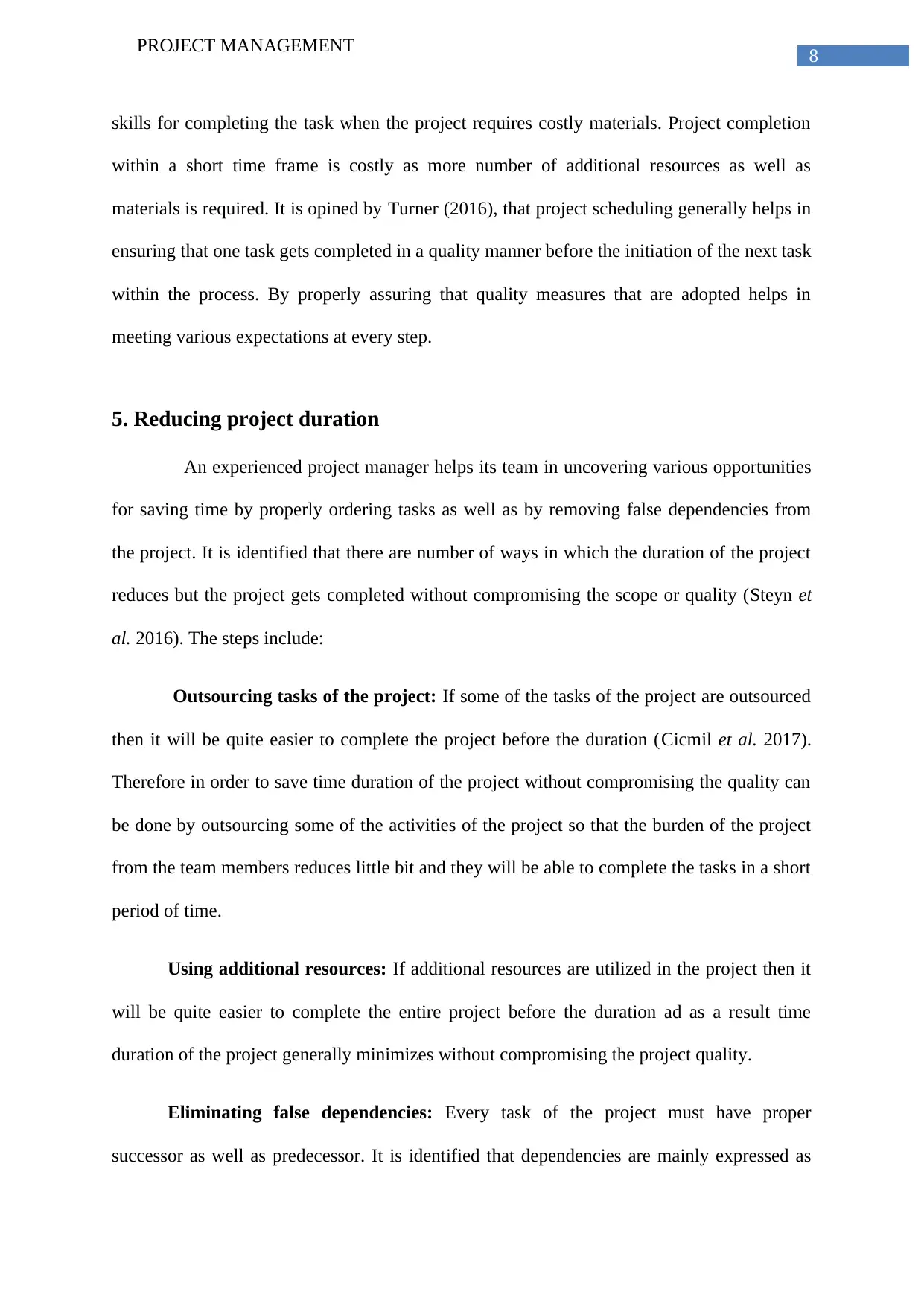
8
PROJECT MANAGEMENT
skills for completing the task when the project requires costly materials. Project completion
within a short time frame is costly as more number of additional resources as well as
materials is required. It is opined by Turner (2016), that project scheduling generally helps in
ensuring that one task gets completed in a quality manner before the initiation of the next task
within the process. By properly assuring that quality measures that are adopted helps in
meeting various expectations at every step.
5. Reducing project duration
An experienced project manager helps its team in uncovering various opportunities
for saving time by properly ordering tasks as well as by removing false dependencies from
the project. It is identified that there are number of ways in which the duration of the project
reduces but the project gets completed without compromising the scope or quality (Steyn et
al. 2016). The steps include:
Outsourcing tasks of the project: If some of the tasks of the project are outsourced
then it will be quite easier to complete the project before the duration (Cicmil et al. 2017).
Therefore in order to save time duration of the project without compromising the quality can
be done by outsourcing some of the activities of the project so that the burden of the project
from the team members reduces little bit and they will be able to complete the tasks in a short
period of time.
Using additional resources: If additional resources are utilized in the project then it
will be quite easier to complete the entire project before the duration ad as a result time
duration of the project generally minimizes without compromising the project quality.
Eliminating false dependencies: Every task of the project must have proper
successor as well as predecessor. It is identified that dependencies are mainly expressed as
PROJECT MANAGEMENT
skills for completing the task when the project requires costly materials. Project completion
within a short time frame is costly as more number of additional resources as well as
materials is required. It is opined by Turner (2016), that project scheduling generally helps in
ensuring that one task gets completed in a quality manner before the initiation of the next task
within the process. By properly assuring that quality measures that are adopted helps in
meeting various expectations at every step.
5. Reducing project duration
An experienced project manager helps its team in uncovering various opportunities
for saving time by properly ordering tasks as well as by removing false dependencies from
the project. It is identified that there are number of ways in which the duration of the project
reduces but the project gets completed without compromising the scope or quality (Steyn et
al. 2016). The steps include:
Outsourcing tasks of the project: If some of the tasks of the project are outsourced
then it will be quite easier to complete the project before the duration (Cicmil et al. 2017).
Therefore in order to save time duration of the project without compromising the quality can
be done by outsourcing some of the activities of the project so that the burden of the project
from the team members reduces little bit and they will be able to complete the tasks in a short
period of time.
Using additional resources: If additional resources are utilized in the project then it
will be quite easier to complete the entire project before the duration ad as a result time
duration of the project generally minimizes without compromising the project quality.
Eliminating false dependencies: Every task of the project must have proper
successor as well as predecessor. It is identified that dependencies are mainly expressed as
⊘ This is a preview!⊘
Do you want full access?
Subscribe today to unlock all pages.

Trusted by 1+ million students worldwide
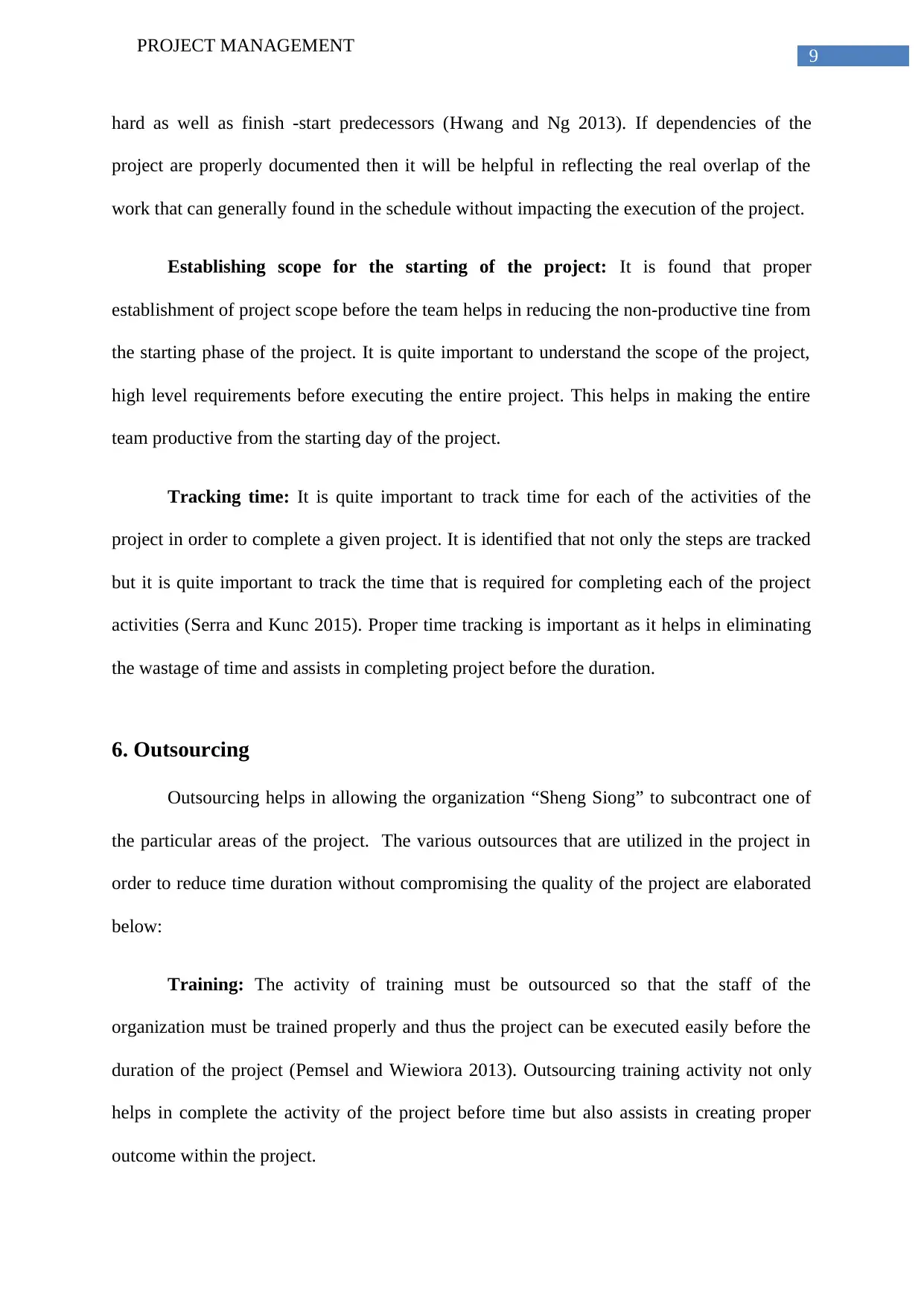
9
PROJECT MANAGEMENT
hard as well as finish -start predecessors (Hwang and Ng 2013). If dependencies of the
project are properly documented then it will be helpful in reflecting the real overlap of the
work that can generally found in the schedule without impacting the execution of the project.
Establishing scope for the starting of the project: It is found that proper
establishment of project scope before the team helps in reducing the non-productive tine from
the starting phase of the project. It is quite important to understand the scope of the project,
high level requirements before executing the entire project. This helps in making the entire
team productive from the starting day of the project.
Tracking time: It is quite important to track time for each of the activities of the
project in order to complete a given project. It is identified that not only the steps are tracked
but it is quite important to track the time that is required for completing each of the project
activities (Serra and Kunc 2015). Proper time tracking is important as it helps in eliminating
the wastage of time and assists in completing project before the duration.
6. Outsourcing
Outsourcing helps in allowing the organization “Sheng Siong” to subcontract one of
the particular areas of the project. The various outsources that are utilized in the project in
order to reduce time duration without compromising the quality of the project are elaborated
below:
Training: The activity of training must be outsourced so that the staff of the
organization must be trained properly and thus the project can be executed easily before the
duration of the project (Pemsel and Wiewiora 2013). Outsourcing training activity not only
helps in complete the activity of the project before time but also assists in creating proper
outcome within the project.
PROJECT MANAGEMENT
hard as well as finish -start predecessors (Hwang and Ng 2013). If dependencies of the
project are properly documented then it will be helpful in reflecting the real overlap of the
work that can generally found in the schedule without impacting the execution of the project.
Establishing scope for the starting of the project: It is found that proper
establishment of project scope before the team helps in reducing the non-productive tine from
the starting phase of the project. It is quite important to understand the scope of the project,
high level requirements before executing the entire project. This helps in making the entire
team productive from the starting day of the project.
Tracking time: It is quite important to track time for each of the activities of the
project in order to complete a given project. It is identified that not only the steps are tracked
but it is quite important to track the time that is required for completing each of the project
activities (Serra and Kunc 2015). Proper time tracking is important as it helps in eliminating
the wastage of time and assists in completing project before the duration.
6. Outsourcing
Outsourcing helps in allowing the organization “Sheng Siong” to subcontract one of
the particular areas of the project. The various outsources that are utilized in the project in
order to reduce time duration without compromising the quality of the project are elaborated
below:
Training: The activity of training must be outsourced so that the staff of the
organization must be trained properly and thus the project can be executed easily before the
duration of the project (Pemsel and Wiewiora 2013). Outsourcing training activity not only
helps in complete the activity of the project before time but also assists in creating proper
outcome within the project.
Paraphrase This Document
Need a fresh take? Get an instant paraphrase of this document with our AI Paraphraser

10
PROJECT MANAGEMENT
Creation of marketing plan: The marketing plan is outsourced so that it can be
created properly so that it would helps in creating positive outcome within the project. It is
identified that outsourcing the marketing plan helps in reducing the project duration.
Theme selection: Selection of theme is outsourced so that proper as well as unique
theme is selected for the project that is not only helpful in reducing the burden but also assists
in completing the project before time (Joslin and Muller 2015).
7. Monitoring progress
The monitoring progress of the project can be highlighted by reflecting the utilization
of earned value as well as scheduling and cost control in the project:-
Earned value management: Earned value management is defined as one of the
technique that helps in controlling cost as well as time performance within a project for
predicting the final project duration as well as cost. It is considered as one of the easy tool
that can be utilized in the project in order to detect early warning signals for detecting various
problems and also for exploiting various opportunities of the project (Beringer, Jonas and
Kock 2013). Earned value forecasting approach assists in predicting the final project cost as
well as duration. The basic assumptions that are generally made for forecasting earned value
management within the project can be measured with the help of SPI metrics for time as well
as CPI for the cost. In addition to this, it is identified that project outcome can be forecasted
for predicting the final cost of the project.
Scheduling and cost control: Scheduling as well as cost control is considered as the
concept that generally helps in serving the foundation of the project management. The project
managers must establish schedule as well as budget before the project initiation phase. It is
identified that setting parameter helps in both time as well as cost time frameworks for laying
PROJECT MANAGEMENT
Creation of marketing plan: The marketing plan is outsourced so that it can be
created properly so that it would helps in creating positive outcome within the project. It is
identified that outsourcing the marketing plan helps in reducing the project duration.
Theme selection: Selection of theme is outsourced so that proper as well as unique
theme is selected for the project that is not only helpful in reducing the burden but also assists
in completing the project before time (Joslin and Muller 2015).
7. Monitoring progress
The monitoring progress of the project can be highlighted by reflecting the utilization
of earned value as well as scheduling and cost control in the project:-
Earned value management: Earned value management is defined as one of the
technique that helps in controlling cost as well as time performance within a project for
predicting the final project duration as well as cost. It is considered as one of the easy tool
that can be utilized in the project in order to detect early warning signals for detecting various
problems and also for exploiting various opportunities of the project (Beringer, Jonas and
Kock 2013). Earned value forecasting approach assists in predicting the final project cost as
well as duration. The basic assumptions that are generally made for forecasting earned value
management within the project can be measured with the help of SPI metrics for time as well
as CPI for the cost. In addition to this, it is identified that project outcome can be forecasted
for predicting the final cost of the project.
Scheduling and cost control: Scheduling as well as cost control is considered as the
concept that generally helps in serving the foundation of the project management. The project
managers must establish schedule as well as budget before the project initiation phase. It is
identified that setting parameter helps in both time as well as cost time frameworks for laying
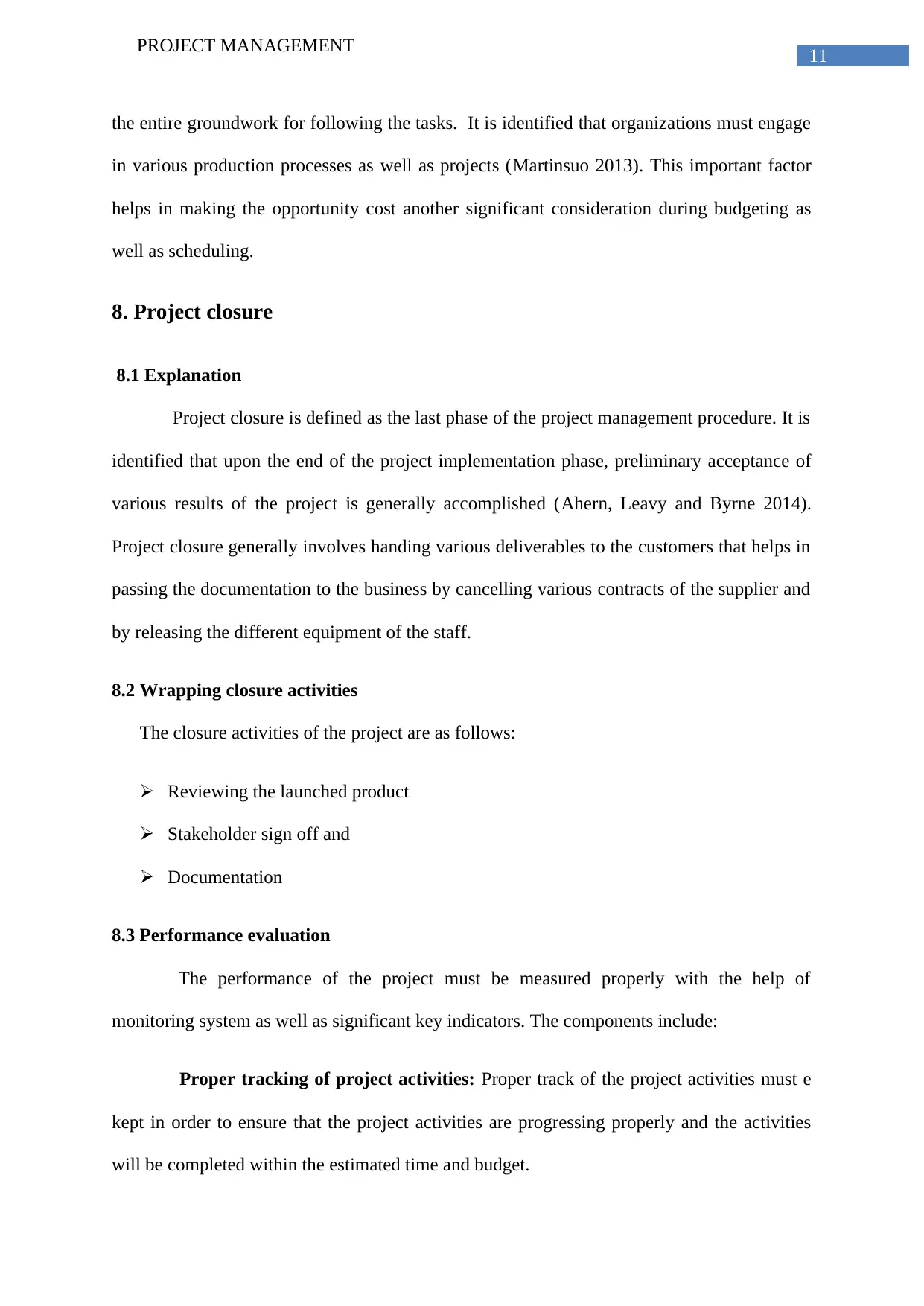
11
PROJECT MANAGEMENT
the entire groundwork for following the tasks. It is identified that organizations must engage
in various production processes as well as projects (Martinsuo 2013). This important factor
helps in making the opportunity cost another significant consideration during budgeting as
well as scheduling.
8. Project closure
8.1 Explanation
Project closure is defined as the last phase of the project management procedure. It is
identified that upon the end of the project implementation phase, preliminary acceptance of
various results of the project is generally accomplished (Ahern, Leavy and Byrne 2014).
Project closure generally involves handing various deliverables to the customers that helps in
passing the documentation to the business by cancelling various contracts of the supplier and
by releasing the different equipment of the staff.
8.2 Wrapping closure activities
The closure activities of the project are as follows:
Reviewing the launched product
Stakeholder sign off and
Documentation
8.3 Performance evaluation
The performance of the project must be measured properly with the help of
monitoring system as well as significant key indicators. The components include:
Proper tracking of project activities: Proper track of the project activities must e
kept in order to ensure that the project activities are progressing properly and the activities
will be completed within the estimated time and budget.
PROJECT MANAGEMENT
the entire groundwork for following the tasks. It is identified that organizations must engage
in various production processes as well as projects (Martinsuo 2013). This important factor
helps in making the opportunity cost another significant consideration during budgeting as
well as scheduling.
8. Project closure
8.1 Explanation
Project closure is defined as the last phase of the project management procedure. It is
identified that upon the end of the project implementation phase, preliminary acceptance of
various results of the project is generally accomplished (Ahern, Leavy and Byrne 2014).
Project closure generally involves handing various deliverables to the customers that helps in
passing the documentation to the business by cancelling various contracts of the supplier and
by releasing the different equipment of the staff.
8.2 Wrapping closure activities
The closure activities of the project are as follows:
Reviewing the launched product
Stakeholder sign off and
Documentation
8.3 Performance evaluation
The performance of the project must be measured properly with the help of
monitoring system as well as significant key indicators. The components include:
Proper tracking of project activities: Proper track of the project activities must e
kept in order to ensure that the project activities are progressing properly and the activities
will be completed within the estimated time and budget.
⊘ This is a preview!⊘
Do you want full access?
Subscribe today to unlock all pages.

Trusted by 1+ million students worldwide
1 out of 14
Related Documents
Your All-in-One AI-Powered Toolkit for Academic Success.
+13062052269
info@desklib.com
Available 24*7 on WhatsApp / Email
![[object Object]](/_next/static/media/star-bottom.7253800d.svg)
Unlock your academic potential
Copyright © 2020–2026 A2Z Services. All Rights Reserved. Developed and managed by ZUCOL.





